Rules for caring for gooseberries after harvest in July and August
Early gooseberries ripen in early June, mid-ripening - in mid or late July, late - in August. To keep the plant healthy and productive, summer residents take care of it not only before picking berries, but also after. Care procedures - watering, pruning, weeding, protection from diseases and pests - make the shrub stronger and prepare it for winter. If you neglect them, next year the yield will decrease, the shoots will grow more slowly. Let's consider in detail what to do with gooseberries after picking berries and what agrotechnical procedures to pay special attention to.
The content of the article
Post-harvest gooseberry care in July - August
Gooseberry care similar to caring for currants. The procedures are simple, requiring no special training or extensive knowledge of gardening. The main thing is to observe the timing of the events and not forget about the nuances.
How to feed gooseberries and currants
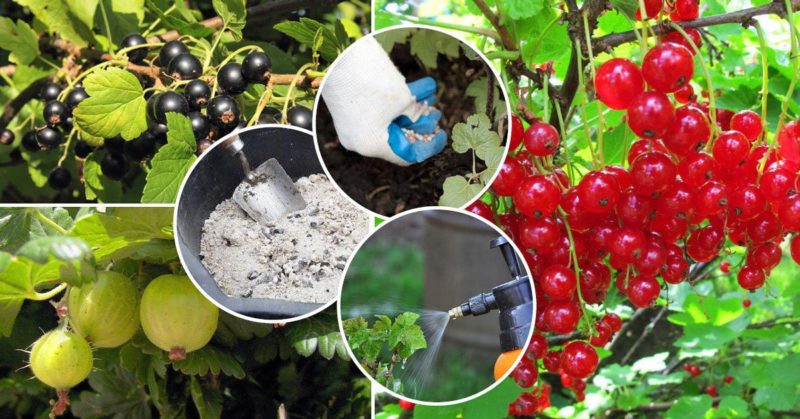
Fertilizing gooseberries and currants after harvesting increases the immunity of berry bushes, their resistance to diseases and pests, prepares the roots and shoots for wintering. For fertilizers, summer residents use organic, mineral or complex fertilizers. Application interval - 15-20 days, depending on the age and condition of the shrub.
How to feed gooseberries after fruiting:
- From mineral fertilizers use potassium sulfate, superphosphate or potassium salt. The components are introduced in liquid form - 30 g of the substance is dissolved in 10 liters of pure water. The shrub is preliminarily watered with warm water, then top dressing is added to the trunk circle. Fertilizer helps to lay the buds for the next year and makes up for the lack of potassium and phosphorus.
- Organic fertilizer used once every 2 years. 300 g of vermicompost is dissolved in 10 liters of water, stirred and brought under the bush. Sprinkle 1 kg of dry wood ash on top and lay out mulch - humus, hay, sawdust, dry grass. It is not recommended to fertilize the soil with organic matter more than once every 2 years - this will lead to an overabundance of substances and diseases.
- At the beginning of autumn, gardeners make ready-made complex fertilizing, for example, liquid fertilizer for berry bushes from Fasco. It stimulates the development of shrubs, increases the stress resistance of gooseberries and currants. Fertilizer "Ryazanochka A" is also used - it contains phosphorus, nitrogen, potassium, boron, zinc, molybdenum and cobalt. To prepare the solution, 10 liters of water and 4 ml of fertilizing are required.
Watering and weeding
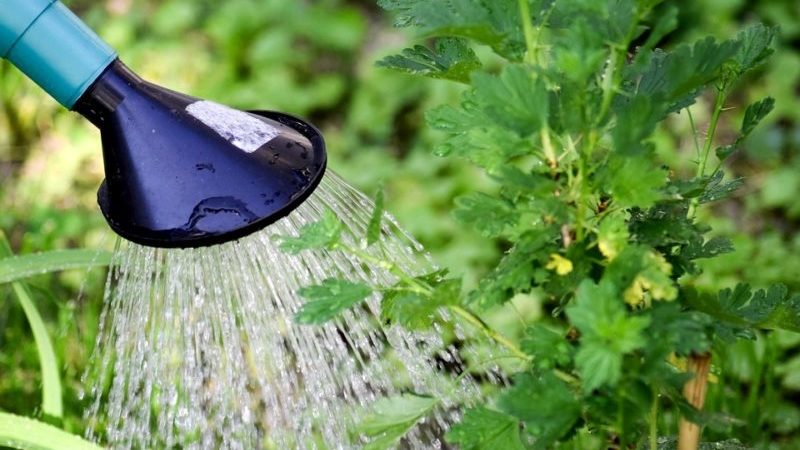
In the first 2 years after planting, the berry needs regular watering- every week, 5-7 liters of water are brought under the bush. After harvesting the fruits, the amount of water is reduced - about 3-4 liters are spent on the bush. It is impossible to forget about watering, since after picking berries, fruit buds are laid from gooseberries and currants. If a drought hits at this time, there will be few of them. After summer, gardeners bring 3-4 buckets of water under each bush.
Attention! To avoid soil erosion and liquid stagnation near the root collar, gardeners dig a groove 5-7 cm deep around the crown perimeter. It is convenient in this case to use drip irrigation - the plants are always moistened, while the water consumption is reduced.
Weed gooseberries and currants as weeds appear under the bushes and in the aisles. The berry must always be kept clean and well-groomed. On the plots, creeping wheatgrass, field bindweed, and dioecious nettle are often found. Remove weeds by hand by pulling them out of the ground by the roots.If weeds are not removed, the likelihood of disease and insect pests increases. Summer residents combine weeding with loosening the soil to a depth of no more than 6 cm.
Pruning
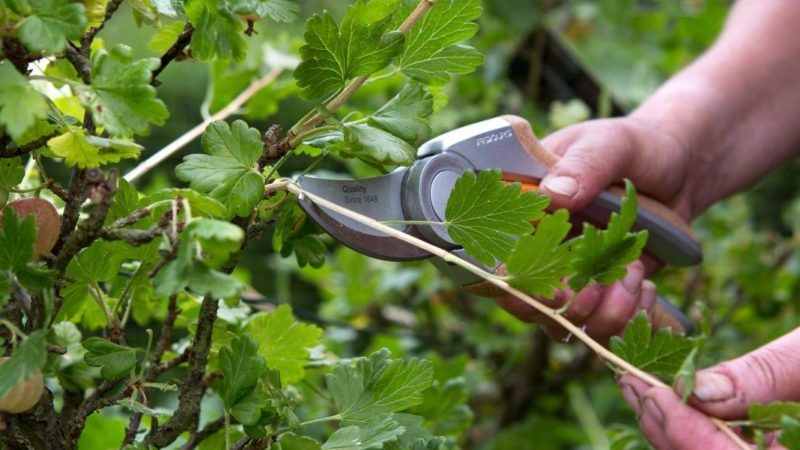
The right time for trimming- late summer or early autumn. In September, shrubs need a sanitary or thinning procedure when diseased, dry and weak shoots are cut. Also, thick branches with shoots and directed inside the bush are subject to removal. Of the branches growing at the base, only 4-5 of the largest and most fruitful are left.
Pruning ensures the correct development of the bush, protects against pests and stimulates the formation of fruit buds. For the procedure, a sharp pruner is used, previously disinfected with a solution of potassium permanganate.
Sometimes the gooseberry is not cut, but thinned out - shoots and short shoots are removed. If this is not done, little light penetrates into the bush, the ovary decreases, and dangerous fungi and bacteria appear.
Treatment against diseases and pests
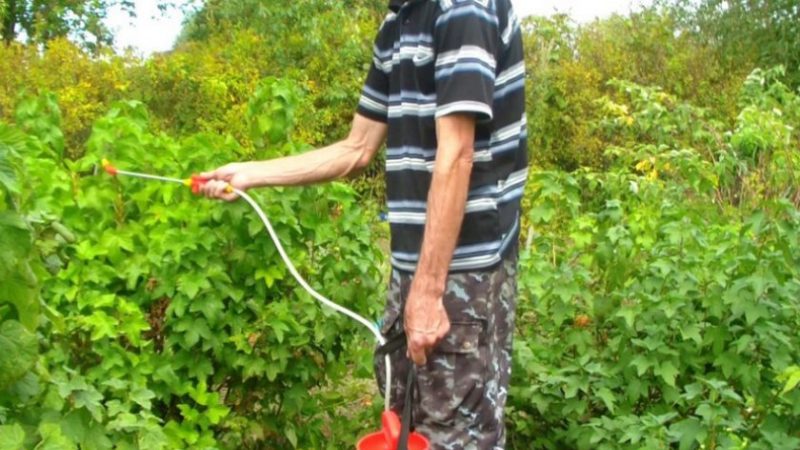
If, after harvesting, signs of disease or insect pests are noticeable behind the bushes, gardeners immediately begin treatment. If you do not do this, you can lose all future crops and the plants themselves.
Of the diseases, shrubs often affect:
- Septoriasis - a fungal disease, accompanied by brown spots, which over time increase in size and cover the entire leaf. The affected plants are removed and burned, and the rest are treated with a solution of Bordeaux liquid or copper sulfate. As preventive measures, loosening and weeding, spraying the bushes with a solution of "Zircon" are used.
- Powdery mildew easy to recognize by white bloom on leaves and shoots. The fungus spreads over the site with the help of wind or rain, it is frost-resistant. Powdery mildew is treated with an ash solution - 50 g of the substance is required per 10 liters. As a preventive measure, a solution of boric acid is used.
- Anthracnose - a fungal disease arising from the thickening of the plantings, high humidity, an excess of trace elements. Accompanied by brown bumps and spots on the leaves... Anthracnose is treated with a solution of copper sulfate - 100 g of the substance is required for 10 liters of water.
Of insects for gooseberries and currants, aphids, spider and kidney mites, glass are dangerous... Weeds, dense plantings, non-observance of the rules of garden neighborhood, and contaminated soil provoke the appearance of pests.
Many larvae hibernate in the ground and appear on the surface only in summer or spring. Get rid of insects using biological insecticides "Kleschegon Super", "Extraflor", "Fitoverm".
Autumn preparation for winter

Preparation for winter is carried out from the beginning of autumn until the first frost. Around the bush, they dig and loosen the soil. If the ground is hard and heavy, use a shovel; if loose and light - pitchfork. When digging, it is recommended to be careful so as not to touch or damage the root system.
Over the entire area of the berry, the soil is dug up by 15-20 cm, under the crown - by 5 cm. Loosening saturates the roots with oxygen, destroys insects and weeds. Along with the procedure, you can add autumn organic fertilizing.
Attention! In the fall, all foliage and debris are removed from under the plant. The collected plant residues are formed in a heap, taken out of the garden area and burned. It is impossible to use the leaves as mulch for the next year - fungi and bacteria can remain on them. After harvesting, the gooseberries are watered abundantly.
How to cover
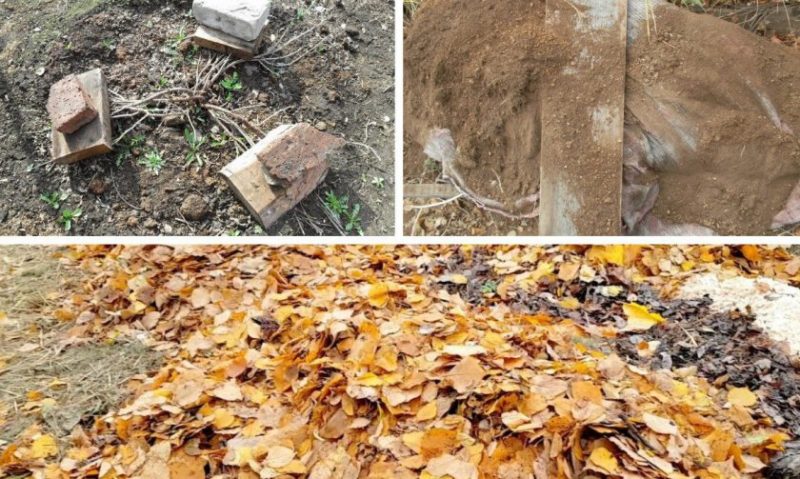
After digging and cleaning, they begin covering work... This is especially true for young bushes growing in cold regions. The trunk circle is lined with mulch: dry branches, vermicompost, moss, rotted manure. In winter, this layer will keep warm and protect the plant from winds and frosts. Additionally, the branches are bent to the ground, sprinkled with earth and covered with pine spruce branches. Sprinkle with snow on top if it has already fallen.
Convenient to use and covering material agrospan. It prevents hypothermia of plants, balances day and night temperatures, protects against diseases and pests. Agrospan is air and light permeable, lightweight and used for 3 years.
Conclusion
After harvesting, gardeners carry out preventive treatment against diseases and pests, and also remove old and diseased shoots. They feed the berry with mineral or organic fertilizers or use ready-made complex preparations.
With the arrival of autumn, all the garbage is removed from the site and burned, the earth under the bush is dug up and mulched. In cold regions, the plant is covered for the winter so that the shoots and roots do not freeze. Caring for a plant after harvest is just as important as during flowering and fruiting. It guarantees a healthy harvest for the next year.